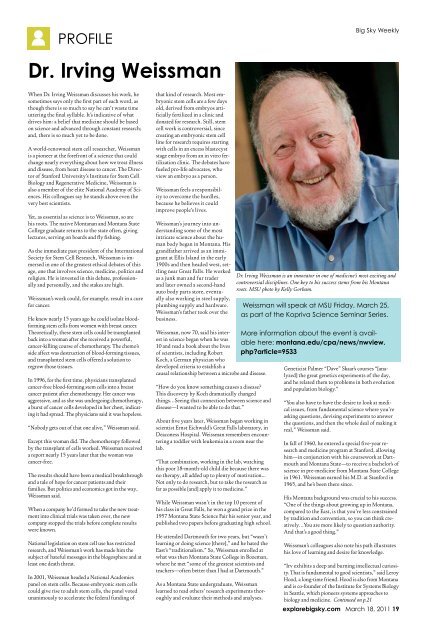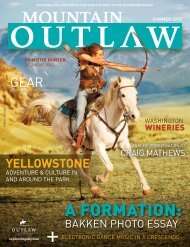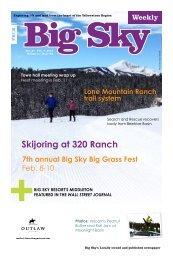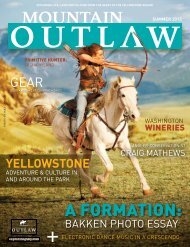Medical - Explore Big Sky
Medical - Explore Big Sky
Medical - Explore Big Sky
You also want an ePaper? Increase the reach of your titles
YUMPU automatically turns print PDFs into web optimized ePapers that Google loves.
ProFile<br />
dr. irving Weissman<br />
When Dr. Irving Weissman discusses his work, he<br />
sometimes says only the first part of each word, as<br />
though there is so much to say he can’t waste time<br />
uttering the final syllable. It’s indicative of what<br />
drives him: a belief that medicine should be based<br />
on science and advanced through constant research;<br />
and, there is so much yet to be done.<br />
A world-renowned stem cell researcher, Weissman<br />
is a pioneer at the forefront of a science that could<br />
change nearly everything about how we treat illness<br />
and disease, from heart disease to cancer. The Director<br />
of Stanford University’s Institute for Stem Cell<br />
Biology and Regenerative Medicine, Weissman is<br />
also a member of the elite National Academy of Sciences.<br />
His colleagues say he stands above even the<br />
very best scientists.<br />
Yet, as essential as science is to Weissman, so are<br />
his roots. The native Montanan and Montana State<br />
College graduate returns to the state often, giving<br />
lectures, serving on boards and fly fishing.<br />
As the immediate past president of the International<br />
Society for Stem Cell Research, Weissman is immersed<br />
in one of the greatest ethical debates of this<br />
age, one that involves science, medicine, politics and<br />
religion. He is invested in this debate, professionally<br />
and personally, and the stakes are high.<br />
Weissman’s work could, for example, result in a cure<br />
for cancer.<br />
He knew nearly 15 years ago he could isolate bloodforming<br />
stem cells from women with breast cancer.<br />
Theoretically, these stem cells could be transplanted<br />
back into a woman after she received a powerful,<br />
cancer-killing course of chemotherapy. The chemo’s<br />
side affect was destruction of blood-forming tissues,<br />
and transplanted stem cells offered a solution to<br />
regrow those tissues.<br />
In 1996, for the first time, physicians transplanted<br />
cancer-free blood-forming stem cells into a breast<br />
cancer patient after chemotherapy. Her cancer was<br />
aggressive, and as she was undergoing chemotherapy,<br />
a burst of cancer cells developed in her chest, indicating<br />
it had spread. The physicians said it was hopeless.<br />
“Nobody gets out of that one alive,” Weissman said.<br />
Except this woman did. The chemotherapy followed<br />
by the transplant of cells worked. Weissman received<br />
a report nearly 15 years later that the woman was<br />
cancer-free.<br />
The results should have been a medical breakthrough<br />
and a tale of hope for cancer patients and their<br />
families. But politics and economics got in the way,<br />
Weissman said.<br />
When a company he’d formed to take the new treatment<br />
into clinical trials was taken over, the new<br />
company stopped the trials before complete results<br />
were known.<br />
National legislation on stem cell use has restricted<br />
research, and Weissman’s work has made him the<br />
subject of hateful messages in the blogosphere and at<br />
least one death threat.<br />
In 2001, Weissman headed a National Academies<br />
panel on stem cells. Because embryonic stem cells<br />
could give rise to adult stem cells, the panel voted<br />
unanimously to accelerate the federal funding of<br />
that kind of research. Most embryonic<br />
stem cells are a few days<br />
old, derived from embryos artificially<br />
fertilized in a clinic and<br />
donated for research. Still, stem<br />
cell work is controversial, since<br />
creating an embryonic stem cell<br />
line for research requires starting<br />
with cells in an excess blastocyst<br />
stage embryo from an in vitro fertilization<br />
clinic. The debates have<br />
fueled pro-life advocates, who<br />
view an embryo as a person.<br />
Weissman feels a responsibility<br />
to overcome the hurdles,<br />
because he believes it could<br />
improve people’s lives.<br />
Weissman’s journey into understanding<br />
some of the most<br />
intricate science about the human<br />
body began in Montana. His<br />
grandfather arrived as an immigrant<br />
at Ellis Island in the early<br />
1900s and then headed west, settling<br />
near Great Falls. He worked<br />
as a junk man and fur trader<br />
and later owned a second-hand<br />
auto body parts store, eventually<br />
also working in steel supply,<br />
plumbing supply and hardware.<br />
Weissman’s father took over the<br />
business.<br />
Weissman, now 70, said his interest<br />
in science began when he was<br />
10 and read a book about the lives<br />
of scientists, including Robert<br />
Koch, a German physician who<br />
developed criteria to establish a<br />
causal relationship between a microbe and disease.<br />
“How do you know something causes a disease?<br />
This discovery by Koch dramatically changed<br />
things…Seeing that connection between science and<br />
disease—I wanted to be able to do that.”<br />
About five years later, Weissman began working in<br />
scientist Ernst Eichwald’s Great Falls laboratory, in<br />
Deaconess Hospital. Weissman remembers encountering<br />
a toddler with leukemia in a room near the<br />
lab.<br />
“That combination, working in the lab, watching<br />
this poor 18-month-old child die because there was<br />
no therapy, all added up to plenty of motivation...<br />
Not only to do research, but to take the research as<br />
far as possible [and] apply it to medicine.”<br />
While Weissman wasn’t in the top 10 percent of<br />
his class in Great Falls, he won a grand prize in the<br />
1957 Montana State Science Fair his senior year, and<br />
published two papers before graduating high school.<br />
He attended Dartmouth for two years, but “wasn’t<br />
learning or doing science [there],” and he hated the<br />
East’s “traditionalism.” So, Weissman enrolled at<br />
what was then Montana State College in Bozeman,<br />
where he met “some of the greatest scientists and<br />
teachers—often better than I had at Dartmouth.”<br />
As a Montana State undergraduate, Weissman<br />
learned to read others’ research experiments thoroughly<br />
and evaluate their methods and analyses.<br />
explorebigsky.com<br />
big sky Weekly<br />
Dr. Irving Weissman is an innovator in one of medicine’s most exciting and<br />
controversial disciplines. One key to his success stems from his Montana<br />
roots. MSU photo by Kelly Gorham.<br />
Weissman will speak at msu Friday, march 25,<br />
as part of the kopriva science seminar series.<br />
more information about the event is available<br />
here: montana.edu/cpa/news/nwview.<br />
php?article=9533<br />
Geneticist Palmer “Dave” Skaar’s courses “[analyzed]<br />
the great genetics experiments of the day,<br />
and he related them to problems in both evolution<br />
and population biology.”<br />
“You also have to have the desire to look at medical<br />
issues, from fundamental science where you’re<br />
asking questions, devising experiments to answer<br />
the questions, and then the whole deal of making it<br />
real,” Weissman said.<br />
In fall of 1960, he entered a special five-year research<br />
and medicine program at Stanford, allowing<br />
him—in conjunction with his coursework at Dartmouth<br />
and Montana State—to receive a bachelor’s of<br />
science in pre-medicine from Montana State College<br />
in 1961. Weissman earned his M.D. at Stanford in<br />
1965, and he’s been there since.<br />
His Montana background was crucial to his success.<br />
“One of the things about growing up in Montana,<br />
compared to the East, is that you’re less constrained<br />
by tradition and convention, so you can think creatively…You<br />
are more likely to question authority.<br />
And that’s a good thing.”<br />
Weissman’s colleagues also note his path illustrates<br />
his love of learning and desire for knowledge.<br />
“Irv exhibits a deep and burning intellectual curiosity.<br />
That is fundamental to good scientists,” said Leroy<br />
Hood, a long-time friend. Hood is also from Montana<br />
and is co-founder of the Institute for Systems Biology<br />
in Seattle, which pioneers systems approaches to<br />
biology and medicine. Continued on p.21<br />
march 18, 2011 19

















